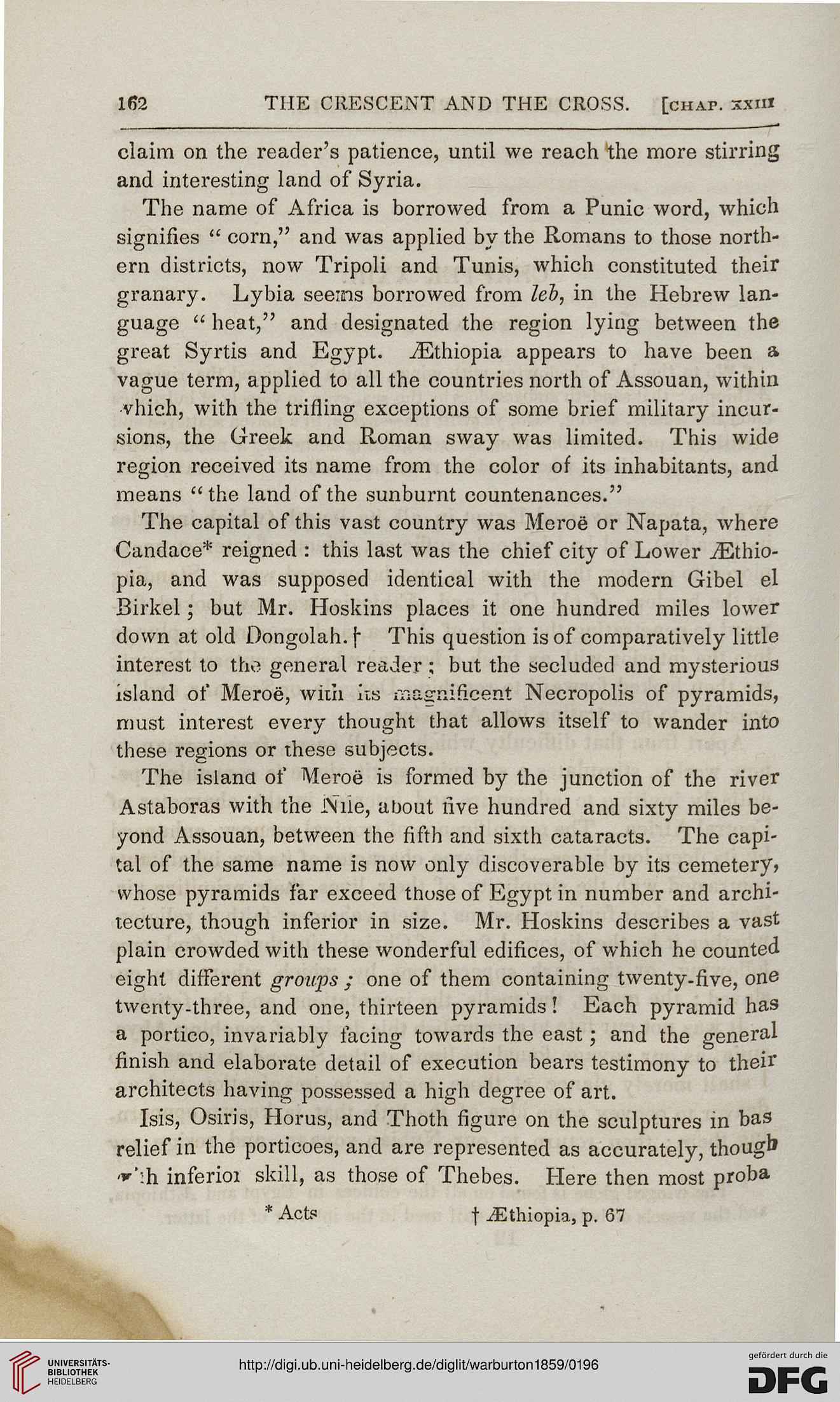162
THE CRESCENT AND THE CROSS. [chap, xxiii
claim on the reader's patience, until we reach the more stirring
and interesting land of Syria.
The name of Africa is borrowed from a Punic word, which
signifies " corn," and was applied by the Romans to those north-
ern districts, now Tripoli and Tunis, which constituted their
granary. Lybia seems borrowed from leb, in the Hebrew lan-
guage " heat," and designated the region lying between the
great Syrtis and Egypt. ./Ethiopia appears to have been a
vague term, applied to all the countries north of Assouan, within
vhich, with the trifling exceptions of some brief military incur-
sions, the Greek and Roman sway was limited. This wide
region received its name from the color of its inhabitants, and
means "the land of the sunburnt countenances."
The capital of this vast country was Meroe or Napata, where
Candace* reigned : this last was the chief city of Lower ^Ethio-
pia, and was supposed identical with the modern Gibel el
Birkel; but Mr. Hoskins places it one hundred miles lower
down at old Dongolah.f This question is of comparatively little
interest to the general reader ; but the secluded and mysterious
island of Meroe, with iis magnificent Necropolis of pyramids,
must interest every thought that allows itself to wander into
these regions or these subjects.
The island of Meroe is formed by the junction of the river
Astaboras with the Nile, about five hundred and sixty miles be-
yond Assouan, between the fifth and sixth cataracts. The capi-
tal of the same name is now only discoverable by its cemetery >
whose pyramids far exceed those of Egypt in number and archi-
tecture, though inferior in size. Mr. Hoskins describes a vast
plain crowded with these wonderful edifices, of which he counted
eight different groups ; one of them containing twenty-five, one
twenty-three, and one, thirteen pyramids! Each pyramid has
a portico, invariably facing towards the east; and the general
finish and elaborate detail of execution bears testimony to their
architects having possessed a high degree of art.
Isis, Osiris, Horus, and Thoth figure on the sculptures in bas
relief in the porticoes, and are represented as accurately, though
'"':h inferioi skill, as those of Thebes. Here then most proba
* Acts f ^Ethiopia, p. 67
THE CRESCENT AND THE CROSS. [chap, xxiii
claim on the reader's patience, until we reach the more stirring
and interesting land of Syria.
The name of Africa is borrowed from a Punic word, which
signifies " corn," and was applied by the Romans to those north-
ern districts, now Tripoli and Tunis, which constituted their
granary. Lybia seems borrowed from leb, in the Hebrew lan-
guage " heat," and designated the region lying between the
great Syrtis and Egypt. ./Ethiopia appears to have been a
vague term, applied to all the countries north of Assouan, within
vhich, with the trifling exceptions of some brief military incur-
sions, the Greek and Roman sway was limited. This wide
region received its name from the color of its inhabitants, and
means "the land of the sunburnt countenances."
The capital of this vast country was Meroe or Napata, where
Candace* reigned : this last was the chief city of Lower ^Ethio-
pia, and was supposed identical with the modern Gibel el
Birkel; but Mr. Hoskins places it one hundred miles lower
down at old Dongolah.f This question is of comparatively little
interest to the general reader ; but the secluded and mysterious
island of Meroe, with iis magnificent Necropolis of pyramids,
must interest every thought that allows itself to wander into
these regions or these subjects.
The island of Meroe is formed by the junction of the river
Astaboras with the Nile, about five hundred and sixty miles be-
yond Assouan, between the fifth and sixth cataracts. The capi-
tal of the same name is now only discoverable by its cemetery >
whose pyramids far exceed those of Egypt in number and archi-
tecture, though inferior in size. Mr. Hoskins describes a vast
plain crowded with these wonderful edifices, of which he counted
eight different groups ; one of them containing twenty-five, one
twenty-three, and one, thirteen pyramids! Each pyramid has
a portico, invariably facing towards the east; and the general
finish and elaborate detail of execution bears testimony to their
architects having possessed a high degree of art.
Isis, Osiris, Horus, and Thoth figure on the sculptures in bas
relief in the porticoes, and are represented as accurately, though
'"':h inferioi skill, as those of Thebes. Here then most proba
* Acts f ^Ethiopia, p. 67




